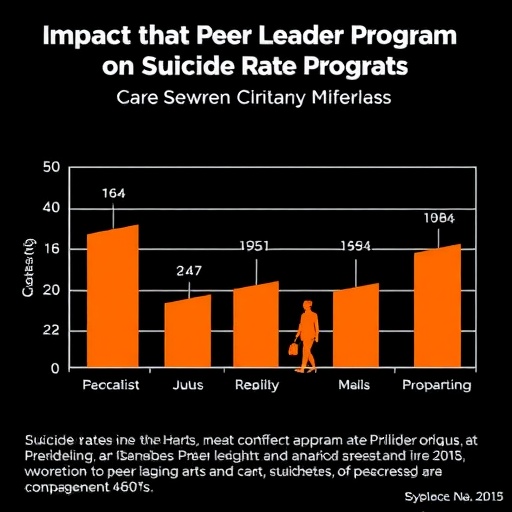In an era where the mental health crisis among adolescents has reached unprecedented levels, innovative approaches are essential for effectively tackling these pressing issues. A recent study sheds light on an impactful intervention known as the Sources of Strength Peer Leader Program, which was rigorously tested in a cluster randomized controlled trial across 40 high schools. The research aims not only to assess the program’s effectiveness but also to contribute significantly to existing literature regarding suicide prevention initiatives in educational settings.
This trial involved a diverse selection of high schools, ensuring a comprehensive representation of various demographics and geographic locations. The researchers sought to determine whether the Sources of Strength program could lead to a measurable decline in suicide attempts among students, an issue that has long plagued both educators and mental health professionals. By incorporating peer leaders as catalysts for change, the program aims to foster resilience and support systems within student populations.
The methodology employed in this research is particularly noteworthy. Schools were randomly assigned to either receive the intervention or to serve as control schools, allowing for a clear comparative analysis of outcomes. Over the course of the study, participants underwent extensive assessments at multiple stages, with focus placed on understanding the dynamics of peer support and its influence on mental health. This rigorous approach strengthens the validity of the findings, positioning them as essential contributions to the field of school mental health.
Central to the Sources of Strength program is the idea that peer influence can significantly alter the landscape of adolescent mental health. By training student leaders to disseminate positive messages and cultivate a culture of openness regarding mental wellness, the program aims to equip students with the resources they need to support their peers. This peer-led model is grounded in the belief that young people are more likely to engage with their friends than with adults in discussions concerning mental health. Therefore, empowering students to take an active role enhances the overall reach of mental health initiatives.
As the trial progressed, researchers meticulously collected data on suicidal ideation and attempts among students. This data provided critical insights into the impact of the peer leader program, revealing trends and patterns that may not have been previously observable. By focusing on these specific metrics, the study aims to illuminate the potential of school-based interventions in reducing rates of self-harm among adolescents.
Moreover, the study underscores the importance of resilience factors in mitigating suicide risks. Resilience, defined as the ability to withstand or recover from difficult life experiences, plays a pivotal role in determining how adolescents cope with stressors related to mental health. The Sources of Strength program explicitly targets these resilience factors by encouraging positive peer relationships and creating an environment where students feel safe discussing vulnerabilities and seeking help.
The results, which are expected to be published in a prominent academic journal, will likely cause ripples through both the academic community and policy-making circles. Should the trial demonstrate statistically significant reductions in suicide attempts, these findings could set a precedent for how mental health interventions are implemented in schools nationwide. Educational policymakers, who are continuously searching for effective ways to address youth mental health crises, will undoubtedly take note of this study’s implications.
Furthermore, the importance of collaborative efforts between mental health professionals, educators, and peer leaders cannot be overstated. This multifaceted approach fosters a holistic environment that not only seeks to address existing mental health issues but also proactively prevents further crises from arising. By crafting a comprehensive support network, the Sources of Strength initiative could very well become a model for other educational institutions aiming to enhance student wellbeing.
In addition, this research aligns with a growing body of literature emphasizing the necessity of early intervention. Addressing mental health issues during adolescence can significantly alter long-term outcomes, reducing the prevalence of mental health disorders in adulthood. Schools, as fundamental social environments for young people, are uniquely positioned to be at the forefront of these preventative efforts. They can facilitate life-saving conversations and promote resources that students might not otherwise access.
As we await the detailed results of this trial, the implications for future research are immense. Should the evidence support the effectiveness of the Sources of Strength program, it will pave the way for further exploration of peer-led interventions across various populations. Researchers could examine how similar frameworks might be adapted for different age groups, cultural contexts, or specific mental health challenges. This research could inspire a wave of innovative practices aimed at addressing the pressing mental health needs of young people.
In conclusion, the Sources of Strength Peer Leader Program represents a promising frontier in school-based mental health interventions. As mental health issues among adolescents continue to rise, it is crucial that we invest in evidence-based strategies that harness the power of peer influence. The outcome of this significant study could catalyze systemic change, encouraging schools to embrace comprehensive mental health initiatives, thus creating safer and healthier environments for future generations.
As we reflect on the journey towards understanding and addressing adolescent mental health, it is essential to remain hopeful and proactive. The commitment of researchers, educators, and peer leaders in pursuing innovative solutions represents a crucial step forward in the ongoing battle against youth suicide. It is through continued dedication and scientific inquiry that we will foster a brighter, healthier future for all students.
Subject of Research: Effects of the Sources of Strength Peer Leader Program on adolescent suicide attempts
Article Title: Impact of the Sources of Strength Peer Leader Program on Suicide Attempt Rates in 40 High Schools: A Cluster Randomized Controlled Trial
Article References:
Wyman, P.A., Cero, I., Pisani, A.R. et al. Impact of the Sources of Strength Peer Leader Program on Suicide Attempt Rates in 40 High Schools: A Cluster Randomized Controlled Trial. School Mental Health (2025). https://doi.org/10.1007/s12310-025-09802-w
Image Credits: AI Generated
DOI:
Keywords: Adolescent mental health, suicide prevention, peer leadership, school intervention, resilience factors.




